Consider the banana. Many people eat one nearly every day. It is considered one of the essential fruits in our North American diet. When I checked the facts, it comes right up there with blackberries and apples for antioxidants and fiber. A lot of us sporty people eat bananas because of the potassium, but it ranks 10th in a list of items we could almost as easily eat to get that desired potassium.  People who want to save money pick and choose which organic fruits and vegetables to buy. Bananas appear to be a bargain because they come with their own peel, a protection against all those bad things farmers do to plants to make them last longer and grow bigger, the GMO and pesticide business.
People who want to save money pick and choose which organic fruits and vegetables to buy. Bananas appear to be a bargain because they come with their own peel, a protection against all those bad things farmers do to plants to make them last longer and grow bigger, the GMO and pesticide business.
I used be eat a banana every day until I gave it up as a protest against the military-industrial complex that undergirds capitalism. Here’s why. Before going to Nicaragua a few years ago, I read the history of the United Fruit Company. An innocent enough beginning: in 1870 a sea captain bought several bunches of bananas in Jamaica for a shilling and sold them for $2 each in Jersey City. What a profit!
Over the next 100 years, the all pervasive import, distribution and marketing of bananas to a fruit-hungry northern population created a military-industrial joint enterprise that exploited Central American countries. Railroads were built in Central America and when they failed to make a profit from ridership, recovery of investment stimulated banana production and sales. An advertising campaign to promote eating bananas set the standard for creating want through ads that fuel the consumerism of Americans today.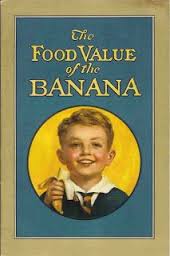
During the 100 years from 1870 to 1970, the US government fought Spain for Cuba and Puerto Rico; took over the postal service of Honduras; ran the Nicaraguan government for a period of time. The US military engaged in operations against Panama, Dominican Republic, Haiti, Honduras, Nicaragua, Guatemala, Costa Rica and El Salvador. The banana figured large in all these military activities.
Bananas were an exotic fruit highly susceptible to a root disease causing vast plantations to be abandoned. The workers lost their livelihood.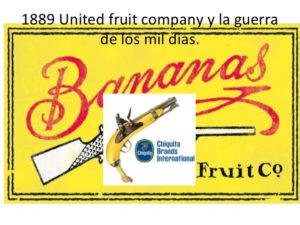 This prompted deals with local Latin American government officials to buy tracks of new land for new plantings. Every attempt by the Central American workers to get better working conditions and higher wages were met with resistance and sometimes, military intervention. Resistance increased. Che Quevara and other leaders took to the streets. Dictators and US government policy and action suppressed protests and
This prompted deals with local Latin American government officials to buy tracks of new land for new plantings. Every attempt by the Central American workers to get better working conditions and higher wages were met with resistance and sometimes, military intervention. Resistance increased. Che Quevara and other leaders took to the streets. Dictators and US government policy and action suppressed protests and 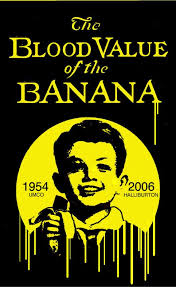 drove workers and their families toward what the US called Communism, though probably unrelated to what was going on in Russia.
drove workers and their families toward what the US called Communism, though probably unrelated to what was going on in Russia.
All this over the banana. I over-simplify. If you google banana, you have to search to find this United Fruit Company history. Today we buy a strain of banana that is less perishable. The price is kept low. For a time there was no import tax at all even though countries fought for that lost revenue.
What struck me in reading the book was the power of advertising developed by the men desperate to market their crop. Over and over the owners of United Fruit had to recover terrible losses from the disease and from labor unrest. One step ahead of bankruptcy, they developed packets describing the value of the banana with maps of Central America and banana-laced recipes for elementary and junior high class room teachers. They discovered a way to dry over-ripe and damaged bananas and sell them to us as healthy snack food (dried banana chips are delicious!) We were hooked. We consumers learned to listen to “facts” about the value of a product to influence our buying habits and our taste buds. Just think about the effort chocolate makers have made to convince us that bitter dark chocolate is good for us as society began to reject milk chocolate as fattening and even addictive. Just notice how many ads on TV recommend foods and medicines.
Global marketing of fruit on a mass scale may have started with the banana. The Slow food and Eat local movements will probably not change the consumption of tropical fruit in North America. We’ve grown accustomed to it.
Glycemic Index
Another reason to question the banana is its place on the Glycemic Index scale. If you are trying to control your weight, lose a few pounds or combat candida, you’ll want to eat foods with the lowest glycemic rating. 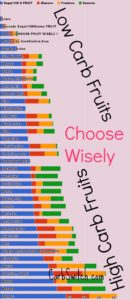
To review: The glycemic index (GI) is a ranking of carbohydrates on a scale from 0 to 100 according to the extent to which they raise blood sugar levels after eating. The banana is an OK choice, but there are better fruits and vegetables. The next time you go for a big workout, a hike or long run, throw an avocado and a spoon in your pack, split it open and eat it for potassium and fiber and good fat. A nice alternative.
I myself am a marketing person and offer a workout drink with banana in it: Physique. Anyone who makes their living by selling something learns to find the sweet spot where the prospect and the product meet. As a society, we probably won’t go back to an earlier time when exotic fruit cost a whole lot of money, like the day I asked my husband to buy me a peach and bring it to the hospital after our daughter was born. It was a cold January day in 1961. The peach came from Israel and cost, if I remember more or less, about $5 which for two students with no income was exorbitant. We do rare things in rare moments.
Enjoy your delicious banana sliced on your bowl of cereal! I’ll pass.
Questions? Comments? I’d love to hear from you on the subject of banana.
Be Well, Do Well and Keep Moving!
Betsy
www.EmpoweredGrandma.com for posts about travel including a 4 part series on Israel and Jordan, January 2016
Shop for Shaklee at www.HiHohealth.com
Shop here. If you are a member, don’t forget to put in your ID number or email. Don’t know your membership ID? Call me 206 933 1889 or Shaklee 1-800-742-5533
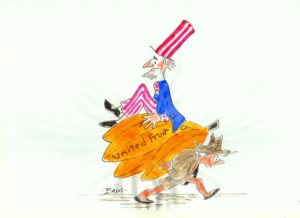
I forgot to mention that we were living in London when our daughter was born, so Israel was the closest place from which tropical fruit was imported. Betsy
Again, Betsy, another wonderful writing! Thank you ever so much!
Good to read regarding your back surgery and how well the unique procedure went what it has done
for you!
May you continue in ‘health’ and again, thx!
Patty Sandberg Schaler